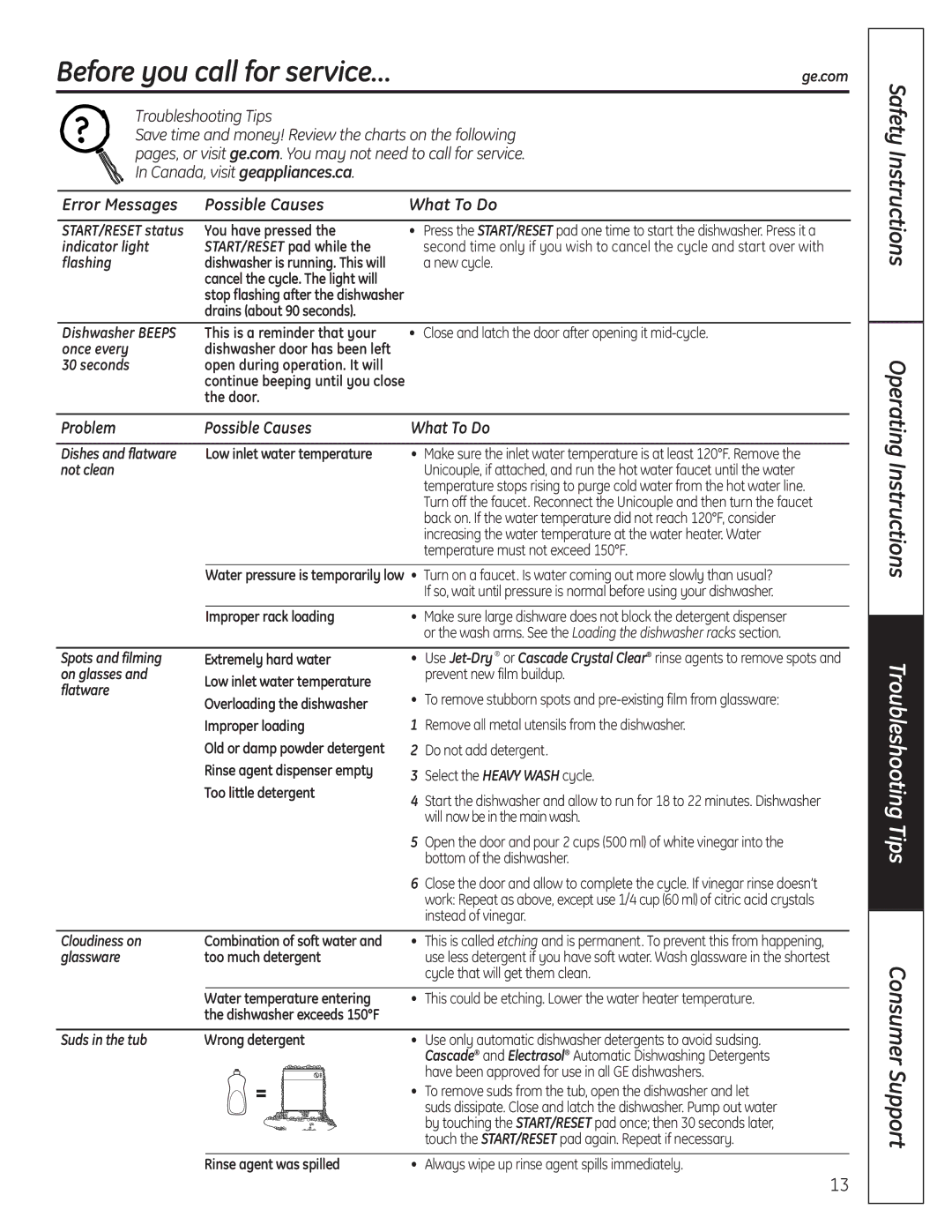
Before you call for service…ge.com
Troubleshooting Tips
Save time and money! Review the charts on the following pages, or visit ge.com. You may not need to call for service. In Canada, visit geappliances.ca.
Error Messages | Possible Causes | What To Do |
START/RESET status | You have pressed the | • Press the START/RESET pad one time to start the dishwasher. Press it a |
indicator light | START/RESET pad while the | second time only if you wish to cancel the cycle and start over with |
flashing | dishwasher is running. This will | a new cycle. |
| cancel the cycle. The light will |
|
| stop flashing after the dishwasher |
|
| drains (about 90 seconds). |
|
Dishwasher BEEPS | This is a reminder that your | • Close and latch the door after opening it |
once every | dishwasher door has been left |
|
30 seconds | open during operation. It will |
|
| continue beeping until you close |
|
| the door. |
|
Problem | Possible Causes | What To Do | ||
Dishes and flatware | Low inlet water temperature | • Make sure the inlet water temperature is at least 120°F. Remove the | ||
not clean |
|
| Unicouple, if attached, and run the hot water faucet until the water | |
|
|
| temperature stops rising to purge cold water from the hot water line. | |
|
|
| Turn off the faucet. Reconnect the Unicouple and then turn the faucet | |
|
|
| back on. If the water temperature did not reach 120°F, consider | |
|
|
| increasing the water temperature at the water heater. Water | |
|
|
| temperature must not exceed 150°F. | |
| Water pressure is temporarily low • Turn on a faucet. Is water coming out more slowly than usual? | |||
|
|
| If so, wait until pressure is normal before using your dishwasher. | |
| Improper rack loading | • Make sure large dishware does not block the detergent dispenser | ||
|
|
| or the wash arms. See the Loading the dishwasher racks section. | |
Spots and filming | Extremely hard water | • | Use | |
on glasses and | Low inlet water temperature |
| prevent new film buildup. | |
flatware | • | To remove stubborn spots and | ||
Overloading the dishwasher | ||||
| ||||
| Improper loading | 1 | Remove all metal utensils from the dishwasher. | |
| Old or damp powder detergent | 2 | Do not add detergent. | |
| Rinse agent dispenser empty | 3 | Select the HEAVY WASH cycle. | |
| Too little detergent | |||
| 4 | Start the dishwasher and allow to run for 18 to 22 minutes. Dishwasher | ||
|
| |||
|
|
| will now be in the main wash. | |
|
| 5 Open the door and pour 2 cups (500 ml) of white vinegar into the | ||
|
|
| bottom of the dishwasher. | |
|
| 6 | Close the door and allow to complete the cycle. If vinegar rinse doesn’t | |
|
|
| work: Repeat as above, except use 1/4 cup (60 ml) of citric acid crystals | |
|
|
| instead of vinegar. | |
Cloudiness on | Combination of soft water and | • | This is called etching and is permanent. To prevent this from happening, | |
glassware | too much detergent |
| use less detergent if you have soft water. Wash glassware in the shortest | |
|
|
| cycle that will get them clean. | |
| Water temperature entering | • | This could be etching. Lower the water heater temperature. | |
| the dishwasherexceeds 150°F |
|
| |
Suds in the tub | Wrong detergent | • | Use only automatic dishwasher detergents to avoid sudsing. | |
|
|
| Cascade® and Electrasol® Automatic Dishwashing Detergents | |
|
|
| have been approved for use in all GE dishwashers. | |
|
| • | To remove suds from the tub, open the dishwasher and let | |
|
|
| suds dissipate. Close and latch the dishwasher. Pump out water | |
|
|
| by touching the START/RESET pad once; then 30 seconds later, | |
|
|
| touch the START/RESET pad again. Repeat if necessary. | |
| Rinse agent was spilled | • | Always wipe up rinse agent spills immediately. | |
13
Safety Instructions
Operating Instructions
Troubleshooting Tips
